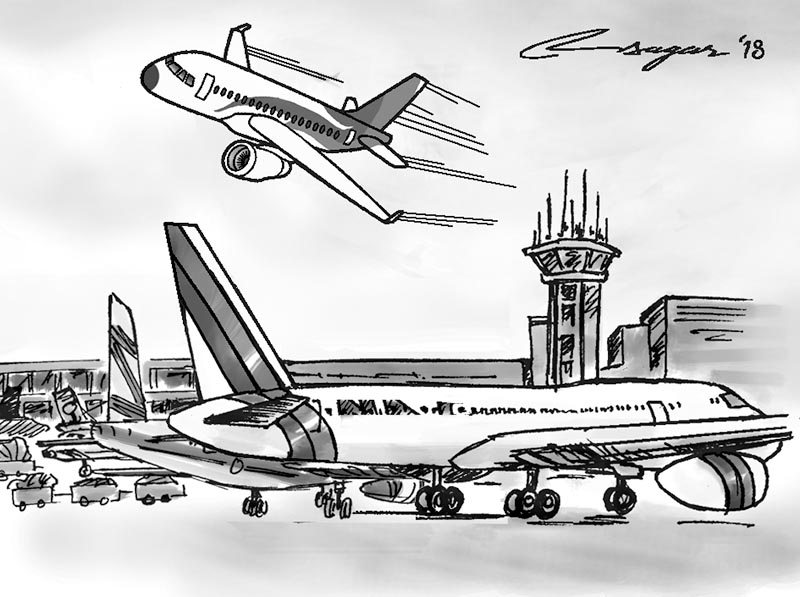Spreading the wings: NAC’s plane purchase
NAC management welcomes constructive criticism as well as scrutiny from authorised institutions if, and only if, there is strong reason to suspect possible irregularity or violation of prevailing laws
Until the late 80s, Nepal Airlines Corporation (NAC) was one of the best airlines in South Asia with a 19-aircraft fleet. Due to various reasons, from the early 90s, the fleet size started decreasing. Thanks to then policy-makers and decision-makers, at one point of time the fleet size of the national flag carrier came down to meagre eight aircraft with only two Boeing B757 on the international front. In the mean time, number of foreign airlines coming to Kathmandu increased from just eight airlines in 1990 to 30 at present.
In the beginning of 2009, NAC management formulated an ambitious plan to expand the fleet and tried their best to avoid tender and purchase directly from the US-based aircraft manufacturing company Boeing. But due to stringent rules in then Public Procurement Act 2063, NAC could not get approval from the government for the direct purchase. Eventually, NAC had no option than to go ahead with global tender. Subsequently, NAC published a tender notice to procure six jets—two wide-body and four narrow-body aircraft—to expand the international network, and Airbus won the contract, solely due to price factor.
News reports in January 2009 of NAC’s fleet expansion plan created quite a stir. Consequently, according to grapevine in travel and tourism circle of the country at that time, a handful of people with some vested interest launched campaigns—covert and overt—against NAC’s expansion plan, especially to thwart the entry of wide-body planes and to protect competitive advantages of few foreign airlines. One cannot also ignore the fact that there is possibility of situation being aggravated by usual phenomenon of noise created by unsuccessful bidders in any kind of tendering processes. Occasional unhealthy competition in trade and industry is a universal phenomenon, and Nepal cannot be an exception.
Then NAC management, therefore, took this volley of tirades against procurement process and so-called irregularities as a normal phenomenon. But what was unfortunate in this particular case was that exceptionally detailed scrutiny of the procurement process was carried out for more than one year from November 2009 to December 2010, which ultimately culminated in the filing of a case by the Commission for the Investigation of Abuse of Authority (CIAA) in the Special Court, thereby derailing the entire fleet expansion project. But the CIAA lost the case both in the Special Court and the Supreme Court. The full text of this land-mark judgment of apex court contains an important statement, which says if any decision, made within the limit of an established norm, tradition or profession, is termed an ill-intentioned decision without any substantial and reliable proof, it will result in the lowering of executives’ decision-making capability and risk-taking ability, which ultimately create a situation where the organisation and the society will suffer negative consequences.
After this final decision from the Supreme Court on April 24, 2012, NAC decided to go ahead with the same aircraft procurement process and finalised a deal with Airbus to procure two narrow-body A320s—of course with an escalated price due to five years delay. The two planes landed in Nepal in the first half of 2015. But the question remains: What did NAC, and for that matter the state, gained from this five-year delay? Members of public have right to know whether the more than one year of investigation into the aircraft purchase “scandal” was carried out due to a strong suspicion of corruption or due to intentionally exaggerated campaign by some unscrupulous elements who had their hidden agenda.
Presently, almost in line with proverbial “history repeating itself”, the purchase of two wide-body A330-200 aircraft has again attracted attention of various quarters. The reality is it is not the decision of only NAC to induct two wide-body jets. The federal budget for this fiscal year also envisaged purchase of two wide-body aircraft—very much in line with NAC’s expansion strategy. NAC’s vision is to launch direct non-stop flights to Japan, South Korea and Saudi Arabia after acquiring two A330s. Based on procedures stipulated in Public Procurement Act 2063—and adhering to the step-by-step process outlined in the financial rule of NAC—a tender was floated on September 26, 2016, wherein there were 11 bidders. Right after NAC board made a final decision on January 16, 2017 to award this wide-body purchase tender to the lowest bidder—the Consortium of US based AAR Corp, German Aviation Capital and Portugal based HIFLY Company. The first anonymous complaint against this board decision was lodged at the CIAA on February 27, 2017.
The tirade against NAC’s decision continued for months, but the purchase process went ahead—there were no other instructions from any quarters including the CIAA. Consequently, the two wide-body aircraft landed at TIA this year. To NAC management’ utter surprise more vigorous campaign about the so-called irregularities in the purchase of the two A330-200s is again being launched.
Of course, NAC management welcomes constructive criticism as well as scrutiny from authorised institutions if, and only if, there is strong reason to suspect possible irregularity or violation of prevailing laws.
Kansakar is managing director of Nepal Airlines Corporation






